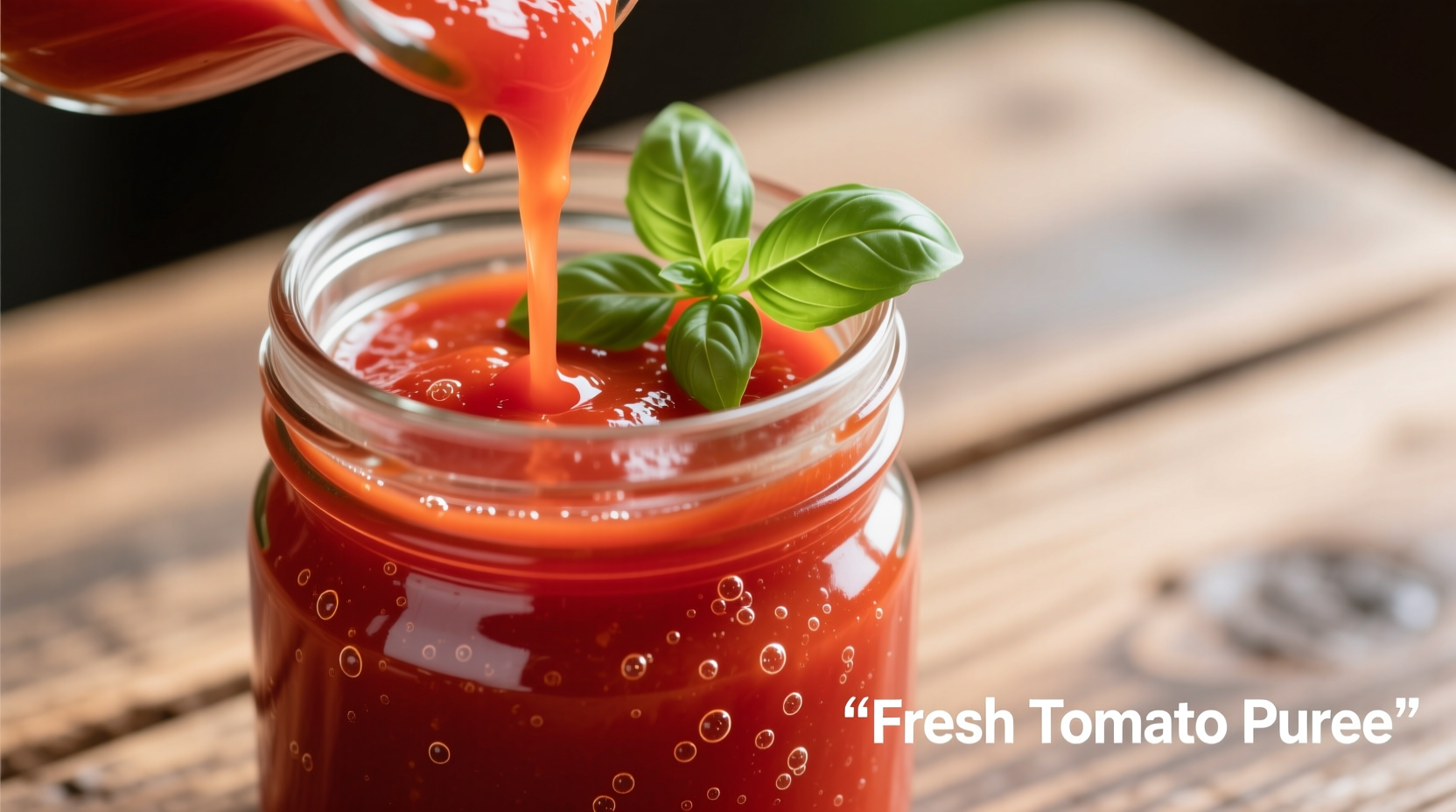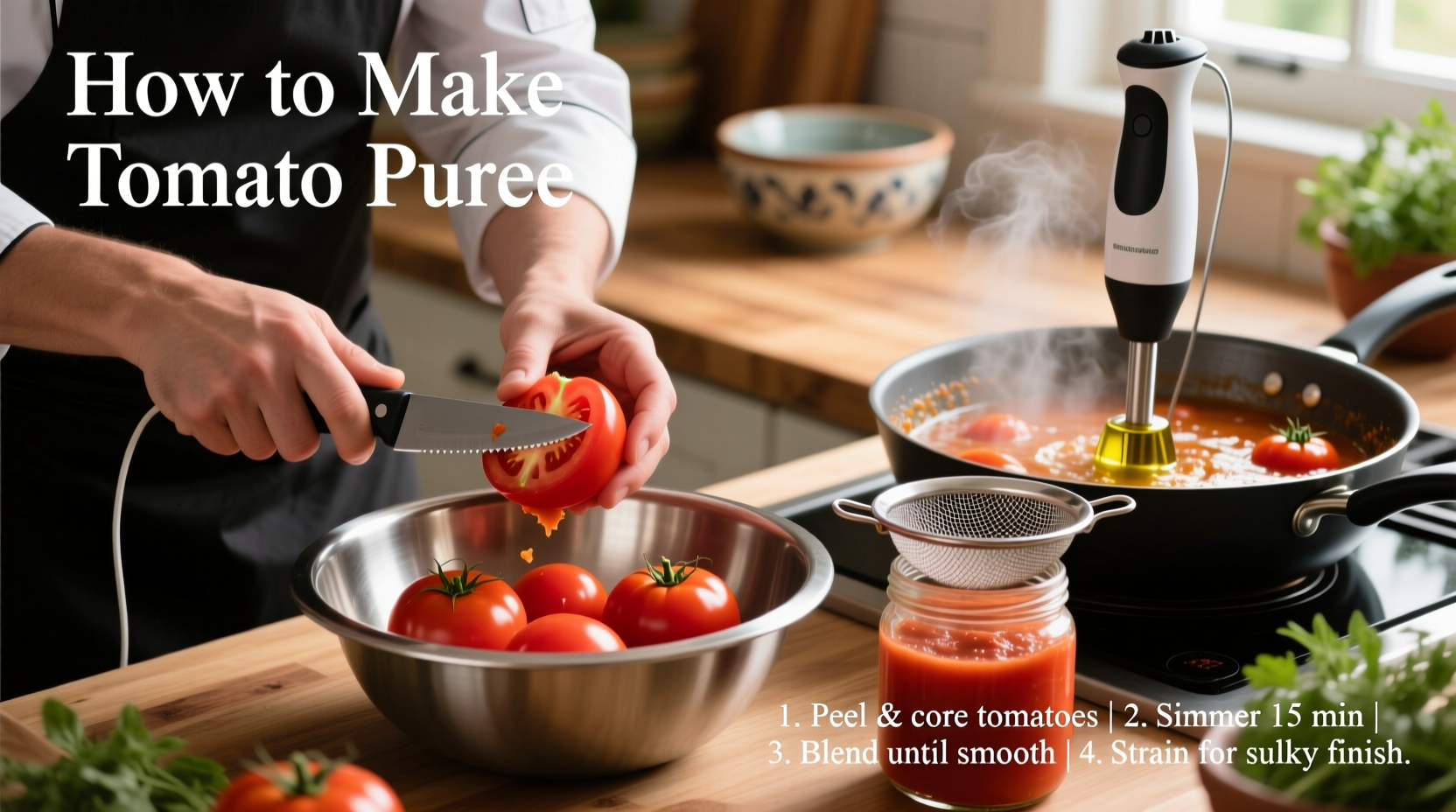Creating vibrant tomato puree at home transforms ordinary dishes into culinary masterpieces. As a professional chef with extensive experience in foundational cooking techniques, I've perfected this essential process that forms the backbone of countless Italian and Mediterranean recipes. Homemade puree delivers unmatched freshness, lets you control ingredient quality, and costs significantly less than premium store-bought versions.
Understanding Tomato Puree: More Than Just Blended Tomatoes
Tomato puree differs from sauce and paste in both texture and concentration. While many confuse these tomato products, understanding their distinctions ensures your recipes achieve perfect results every time.
| Product | Texture | Water Content | Common Uses |
|---|---|---|---|
| Tomato Puree | Smooth, pourable | ~90% | Base for sauces, soups, stews |
| Tomato Sauce | Thicker, seasoned | ~85% | Ready-to-use in pasta dishes |
| Tomato Paste | Very thick, concentrated | ~65% | Flavor enhancer, small quantities |
Why Homemade Beats Store-Bought
Commercial tomato purees often contain preservatives and stabilizers that alter flavor and texture. When you make your own, you control exactly what goes in - just tomatoes and perhaps a pinch of salt. The USDA's Food Safety and Inspection Service confirms that properly prepared and stored homemade tomato products maintain superior nutritional value compared to processed alternatives (FSIS Home Food Preservation Guidelines).
Essential Ingredients and Equipment
You'll need just a few simple items to create professional-quality tomato puree:
- Fresh tomatoes: Roma or San Marzano varieties work best due to their lower water content and rich flavor
- Basic equipment: Large pot, immersion blender or food processor, fine-mesh strainer (optional)
- Optional enhancements: 1-2 garlic cloves, fresh basil, or a pinch of sugar to balance acidity
Step-by-Step Preparation Process
Follow this professional chef-tested method for perfect tomato puree every time:
- Prep the tomatoes: Score an "X" on the bottom of each tomato. Blanch in boiling water for 60 seconds, then transfer to ice water. The skins will peel off easily.
- Simmer gently: Place peeled tomatoes in a large pot over medium heat. Cook uncovered for 30-45 minutes, stirring occasionally, until liquid reduces by about one-third.
- Blend smoothly: Use an immersion blender directly in the pot for safest results, or transfer to a food processor in batches. Blend until completely smooth.
- Strain (optional): For ultra-smooth puree, press through a fine-mesh strainer to remove any remaining seeds or fibrous bits.
- Season: Add salt to taste (about 1/4 teaspoon per pound of tomatoes). Avoid sugar unless tomatoes are exceptionally acidic.

Timing Breakdown: What to Expect
Understanding the time investment helps plan your cooking process effectively:
- Preparation: 15 minutes (washing, scoring, blanching)
- Cooking: 30-45 minutes (simmering to reduce liquid)
- Processing: 5 minutes (blending and straining)
- Total active time: 50-65 minutes
Storage Solutions for Maximum Freshness
Proper storage extends your puree's shelf life while maintaining quality:
- Refrigeration: Store in airtight containers for up to 5 days
- Freezing: Portion into ice cube trays, then transfer to freezer bags for up to 12 months
- Canning: Follow USDA guidelines for water bath canning (requires proper acidity testing)
The National Center for Home Food Preservation recommends maintaining proper acidity levels when canning tomato products to prevent bacterial growth (NCHFP Guidelines).
Common Mistakes to Avoid
Even experienced cooks encounter these pitfalls when making tomato puree:
- Skipping the blanching step: Makes peeling difficult and leaves unpleasant skin bits in your puree
- Over-reducing: Cooking too long creates paste rather than puree - watch for the right consistency
- Using unripe tomatoes: Results in overly acidic, less flavorful puree
- Adding oil during cooking: Causes splattering and makes blending more difficult
Culinary Applications Beyond Pasta Sauce
Tomato puree serves as a versatile foundation for numerous dishes:
- Base for shakshuka and other egg dishes
- Foundation for gazpacho and cold tomato soups
- Ingredient in homemade ketchup and barbecue sauces
- Moisture component in tomato bread and pizza dough
- Base for vegetable stews and braises
When Store-Bought Makes Sense
While homemade generally delivers superior flavor, commercial puree has its place:
- During winter months when fresh tomatoes lack flavor
- When you need consistent results for large-batch cooking
- For emergency cooking when fresh ingredients aren't available
- When time constraints make homemade impractical
Perfecting Your Technique: Pro Tips
Elevate your tomato puree with these professional chef insights:
- Add a small piece of carrot during cooking to naturally balance acidity without sugar
- For deeper flavor, roast tomatoes at 375°F (190°C) for 20 minutes before simmering
- Freeze puree in 1-cup portions matching standard recipe requirements
- When using frozen puree in sauces, add it directly from frozen without thawing
Frequently Asked Questions
Can I make tomato puree without peeling the tomatoes?
Yes, but the texture will be less smooth. The skins contain fiber that doesn't fully break down during blending. For sauces where texture matters less (like stews), unpeeled tomatoes work acceptably, but for pasta sauces or soups requiring smooth consistency, peeling is recommended.
How do I prevent my tomato puree from becoming too watery?
Simmer uncovered to allow excess liquid to evaporate. Roma tomatoes naturally contain less water than other varieties. If your puree is too thin, continue simmering for 10-15 minutes while stirring frequently until it reaches your desired consistency - it should coat the back of a spoon.
Is tomato puree the same as tomato passata?
They're similar but not identical. Passata is Italian-style uncooked tomato puree that's strained to remove seeds and skins. Traditional tomato puree is cooked, which develops deeper flavor but reduces some fresh tomato brightness. Passata works well in dishes where you want fresh tomato flavor without cooking the tomatoes first.
Can I use canned tomatoes to make puree?
Absolutely. High-quality canned San Marzano tomatoes make excellent puree, especially when fresh tomatoes aren't in season. Simply drain the canned tomatoes, then blend until smooth. You may need to simmer briefly to reduce excess liquid from the canning process. This method produces consistent results year-round.











 浙公网安备
33010002000092号
浙公网安备
33010002000092号 浙B2-20120091-4
浙B2-20120091-4